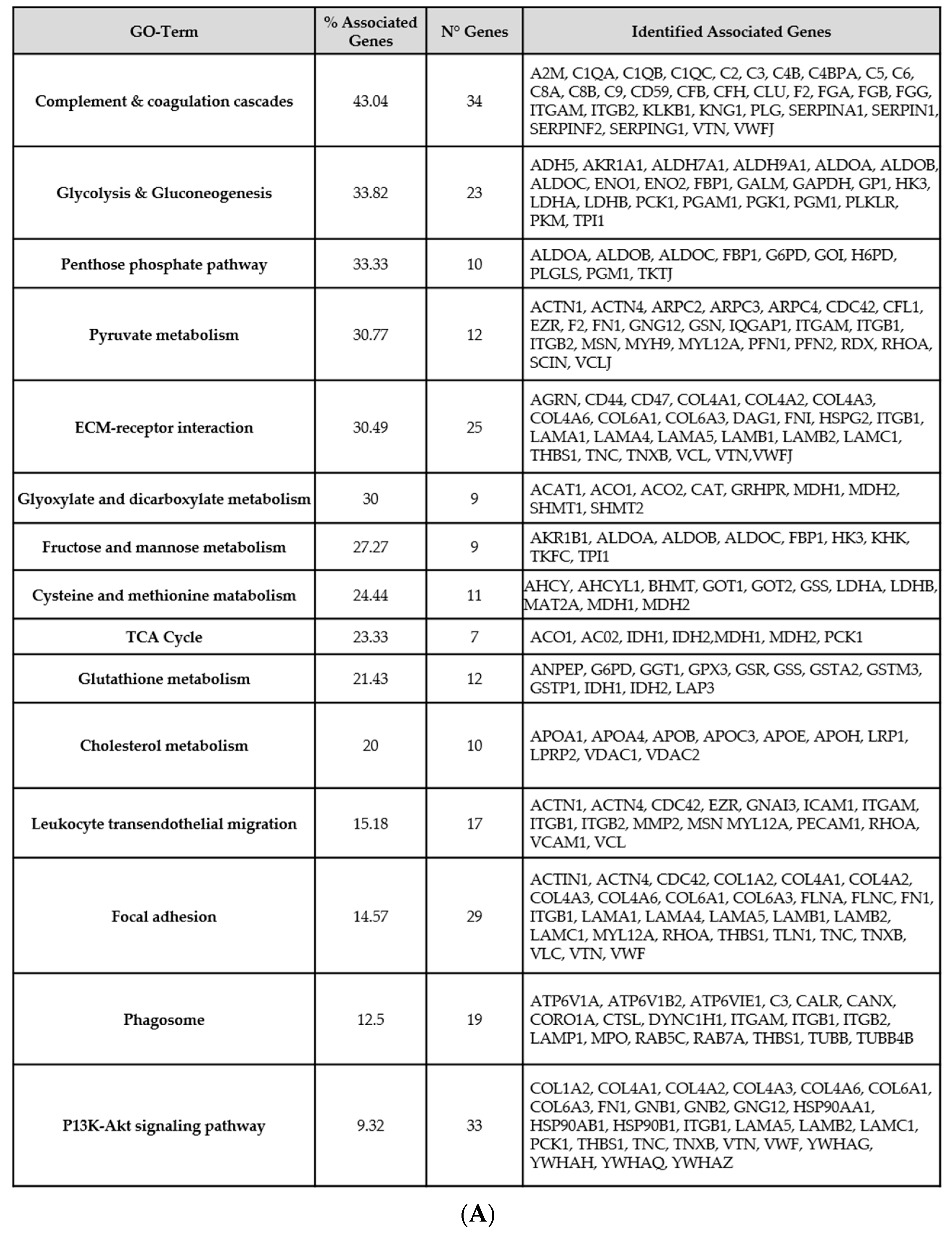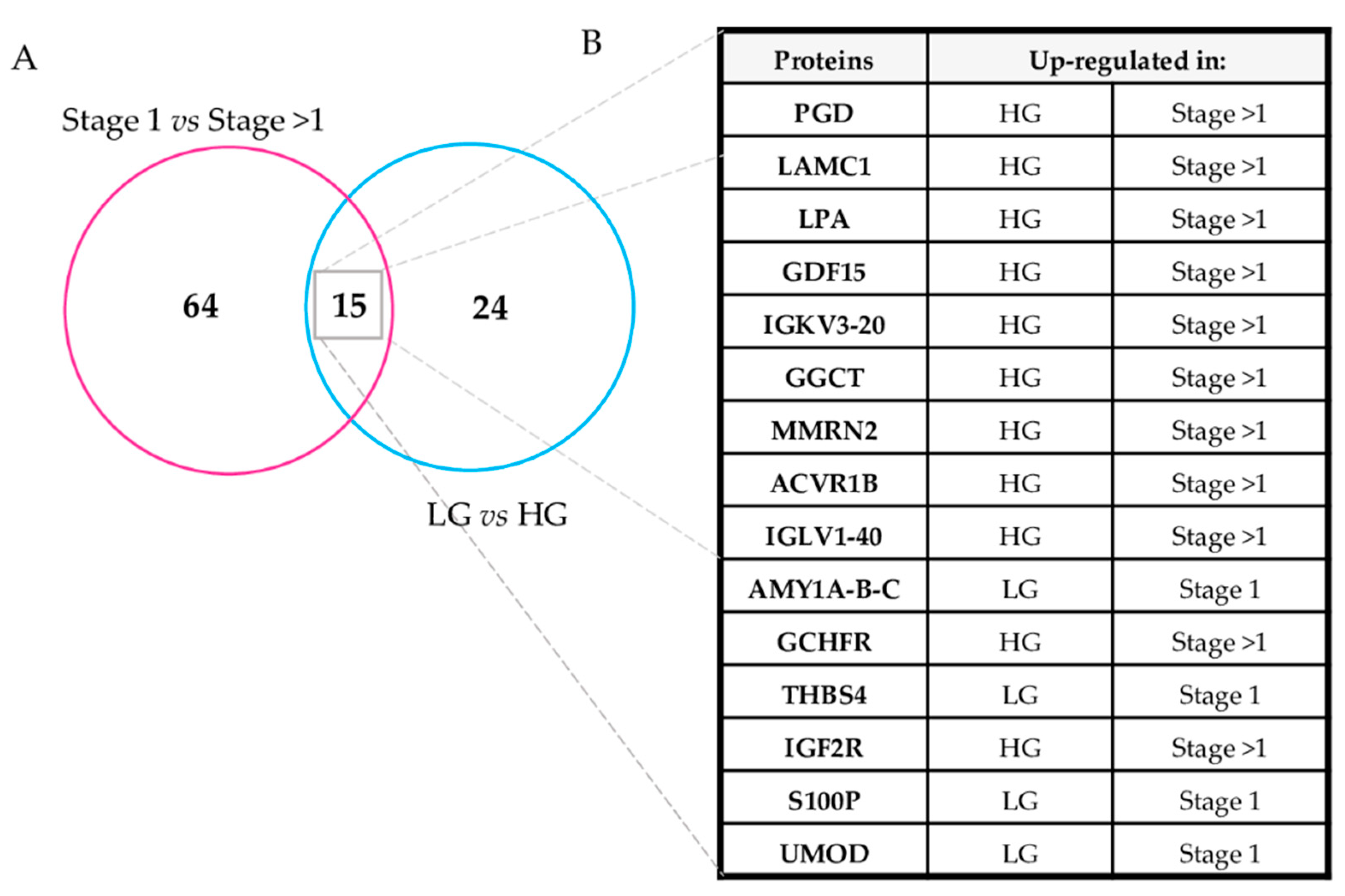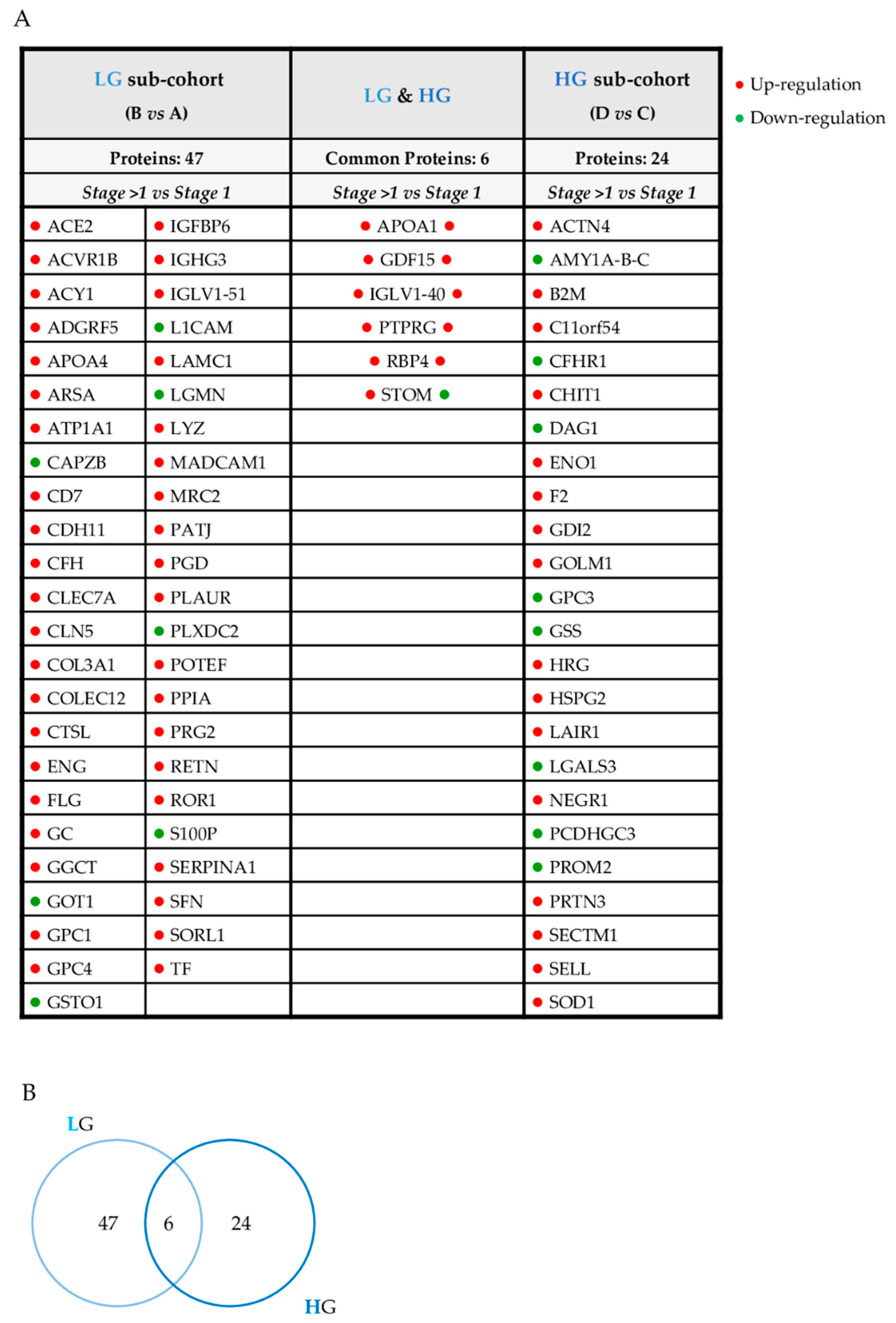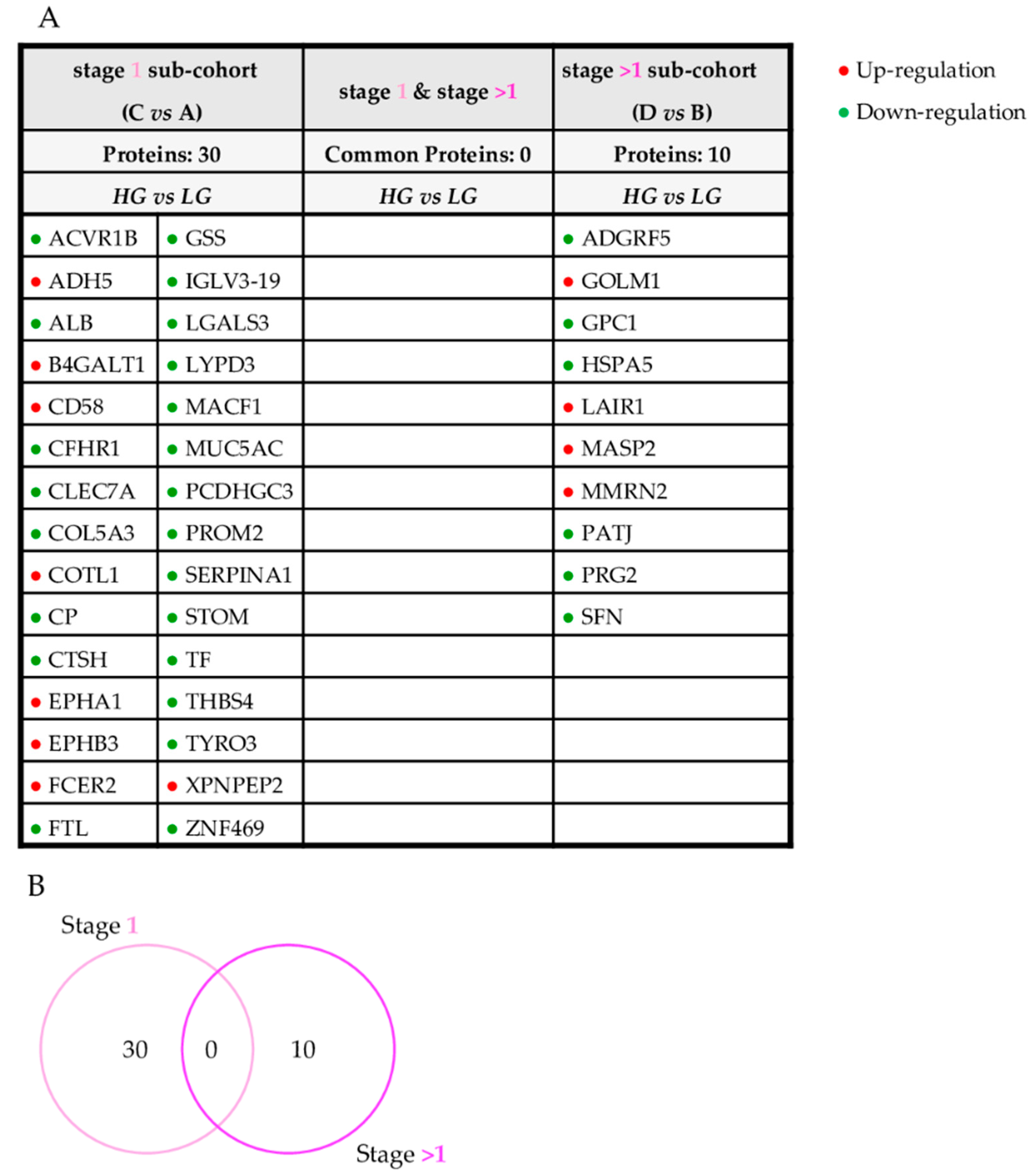Does the Urinary Proteome Reflect ccRCC Stage and Grade Progression?
Abstract
:1. Introduction
2. Materials and Methods
2.1. Patient Selection
2.2. Sample Collection and Preparation
2.3. nUHPLC-MS/MS Analysis
2.4. Data Processing
3. Results
3.1. Clinical Data and Study Design
3.2. Qualitative Evaluation and Network Analysis: Relevant Pathways of ccRCC
3.3. Quantitative Evaluation: Urinary Proteins Varying According to Different Grade and Stage
4. Discussion
4.1. Urine as a Molecular Portrait of ccRCC
4.2. ccRCC Urinary Proteome Mirrors Grade and Stage Classification
5. Conclusions
Supplementary Materials
Author Contributions
Funding
Institutional Review Board Statement
Informed Consent Statement
Conflicts of Interest
References
- Chinello, C.; L’Imperio, V.; Stella, M.; Smith, A.J.; Bovo, G.; Grasso, A.; Grasso, M.; Raimondo, F.; Pitto, M.; Pagni, F.; et al. The proteomic landscape of renal tumors. Expert Rev. Proteom. 2016, 13, 1103–1120. [Google Scholar] [CrossRef] [PubMed]
- Ricketts, C.J.; De Cubas, A.A.; Fan, H.; Smith, C.C.; Lang, M.; Reznik, E.; Bowlby, R.; Gibb, E.A.; Akbani, R.; Beroukhim, R.; et al. The Cancer Genome Atlas Research Network Comprehensive molecular characterization of clear cell renal cell carcinoma. Nature 2013, 499, 43–49. [Google Scholar] [CrossRef] [Green Version]
- Ball, M.W. Surgical management of metastatic renal cell carcinoma. Discov. Med. 2017, 23, 379–387. [Google Scholar] [PubMed]
- Haddad, A.Q.; Margulis, V. Tumour and patient factors in renal cell carcinoma—Towards personalized therapy. Nat. Rev. Urol. 2015, 12, 253–262. [Google Scholar] [CrossRef] [PubMed]
- Van den Berg, E. Renal Cell Carcinoma. In Brenner’s Encyclopedia of Genetics, 2nd ed.; Academic Press: Cambridge, MA, USA, 2013; pp. 130–132. [Google Scholar]
- Swami, U.; Nussenzveig, R.H.; Haaland, B.; Agarwal, N. Revisiting AJCC TNM staging for renal cell carcinoma: Quest for improvement. Ann. Transl. Med. 2019, 7, S18. [Google Scholar] [CrossRef]
- Delahunt, B.; Eble, J.N.; Egevad, L.; Samaratunga, H. Grading of renal cell carcinoma. Histopathology 2018, 74, 4–17. [Google Scholar] [CrossRef] [Green Version]
- Fuhrman, S.A.; Lasky, L.C.; Limas, C. Prognostic significance of morphologic parameters in renal cell carcinoma. Am. J. Surg. Pathol. 1982, 6, 655–664. [Google Scholar] [CrossRef] [PubMed]
- Because, C.; Diverse, O. Early diagnosis improves survival in kidney cancer. Practitioner 2012, 256, 13–16. [Google Scholar]
- Sandim, V.; Pereira, D.D.A.; Ornellas, A.A.; Alves, G. Renal Cell Carcinoma and Proteomics. Urol. Int. 2010, 84, 373–377. [Google Scholar] [CrossRef]
- Di Meo, A.; Bartlett, J.; Cheng, Y.; Pasic, M.D.; Yousef, G.M. Liquid biopsy: A step forward towards precision medicine in urologic malignancies. Mol. Cancer 2017, 16, 80. [Google Scholar] [CrossRef]
- Santorelli, L.; Morello, W.; Barigazzi, E.; Capitoli, G.; Tamburello, C.; Ghio, L.; Crapella, B.; Galimberti, S.; Montini, G.; Pitto, M.; et al. Urinary Extracellular Vesicle Protein Profiles Discriminate Different Clinical Subgroups of Children with Idiopathic Nephrotic Syndrome. Diagnostics 2021, 11, 456. [Google Scholar] [CrossRef]
- Caterino, M.; Ruoppolo, M.; Villani, G.R.D.; Marchese, E.; Costanzo, M.; Sotgiu, G.; Dore, S.; Franconi, F.; Campesi, I. Influence of Sex on Urinary Organic Acids: A Cross-Sectional Study in Children. Int. J. Mol. Sci. 2020, 21, 582. [Google Scholar] [CrossRef] [Green Version]
- Santorelli, L.; Barigazzi, E.; Pitto, M.; Raimondo, F. Investigation of the N-Glycoproteome in the Urinary Exosomes: Technical Challenges. In Toxic Chemical and Biological Agents; Springer: Dordrecht, The Netherlands, 2020; pp. 257–258. [Google Scholar] [CrossRef]
- Caterino, M.; Zacchia, M.; Costanzo, M.; Bruno, G.; Arcaniolo, D.; Trepiccione, F.; Siciliano, R.A.; Mazzeo, M.F.; Ruoppolo, M.; Capasso, G. Urine Proteomics Revealed a Significant Correlation Between Urine-Fibronectin Abundance and Estimated-GFR Decline in Patients with Bardet-Biedl Syndrome. Kidney Blood Press. Res. 2018, 43, 389–405. [Google Scholar] [CrossRef]
- Raimondo, F.; Morosi, L.; Chinello, C.; Magni, F.; Pitto, M. Advances in membranous vesicle and exosome proteomics improving biological understanding and biomarker discovery. Proteomics 2011, 11, 709–720. [Google Scholar] [CrossRef] [PubMed]
- Klein, J.; Bascands, J.-L.; Mischak, H.; Schanstra, J.P. The role of urinary peptidomics in kidney disease research. Kidney Int. 2016, 89, 539–545. [Google Scholar] [CrossRef] [Green Version]
- Zhang, M.; Liu, X.; Liu, X.; Li, H.; Sun, W.; Zhang, Y. A pilot investigation of a urinary metabolic biomarker discovery in renal cell carcinoma. Int. Urol. Nephrol. 2019, 52, 437–446. [Google Scholar] [CrossRef] [PubMed]
- Oto, J.; Fernández-Pardo, Á.; Roca, M.; Plana, E.; Solmoirago, M.J.; Sánchez-González, J.V.; Vera-Donoso, C.D.; Martínez-Sarmiento, M.; España, F.; Navarro, S.; et al. Urine metabolomic analysis in clear cell and papillary renal cell carcinoma: A pilot study. J. Proteom. 2020, 218, 103723. [Google Scholar] [CrossRef]
- Arendowski, A.; Ossoliński, K.; Ossolińska, A.; Ossoliński, T.; Nizioł, J.; Ruman, T. Serum and urine analysis with gold nanoparticle-assisted laser desorption/ionization mass spectrometry for renal cell carcinoma metabolic biomarkers discovery. Adv. Med. Sci. 2021, 66, 326–335. [Google Scholar] [CrossRef]
- Morrissey, J.J.; Mobley, J.; Song, J.; Vetter, J.; Luo, J.; Bhayani, S.; Figenshau, R.S.; Kharasch, E.D. Urinary Concentrations of Aquaporin-1 and Perilipin-2 in Patients with Renal Cell Carcinoma Correlate with Tumor Size and Stage but not Grade. Urology 2013, 83, 256.e9. [Google Scholar] [CrossRef] [PubMed] [Green Version]
- Sandim, V.; Pereira, D.D.A.; Kalume, D.E.; Oliveira-Carvalho, A.L.; Ornellas, A.A.; Soares, M.R.; Alves, G.; Zingali, R.B. Proteomic analysis reveals differentially secreted proteins in the urine from patients with clear cell renal cell carcinoma. Urol. Oncol. Semin. Orig. Investig. 2016, 34, 5.e11. [Google Scholar] [CrossRef]
- Gianazza, E.; Chinello, C.; Mainini, V.; Cazzaniga, M.; Squeo, V.; Albo, G.; Signorini, S.; Di Pierro, S.S.; Ferrero, S.; Nicolardi, S.; et al. Alterations of the serum peptidome in renal cell carcinoma discriminating benign and malignant kidney tumors. J. Proteom. 2012, 76, 125–140. [Google Scholar] [CrossRef] [PubMed]
- Costanzo, M.; Cevenini, A.; Marchese, E.; Imperlini, E.; Raia, M.; Del Vecchio, L.; Caterino, M.; Ruoppolo, M. Label-Free Quantitative Proteomics in a Methylmalonyl-CoA Mutase-Silenced Neuroblastoma Cell Line. Int. J. Mol. Sci. 2018, 19, 3580. [Google Scholar] [CrossRef] [Green Version]
- De Pasquale, V.; Costanzo, M.; Siciliano, R.A.; Mazzeo, M.F.; Pistorio, V.; Bianchi, L.; Marchese, E.; Ruoppolo, M.; Pavone, L.M.; Caterino, M. Proteomic Analysis of Mucopolysaccharidosis IIIB Mouse Brain. Biomolecules 2020, 10, 355. [Google Scholar] [CrossRef] [PubMed] [Green Version]
- Ma, B.; Zhang, K.; Hendrie, C.; Liang, C.; Li, M.; Doherty-Kirby, A.; Lajoie, G. PEAKS: Powerful software for peptidede novo sequencing by tandem mass spectrometry. Rapid Commun. Mass Spectrom. 2003, 17, 2337–2342. [Google Scholar] [CrossRef]
- Doncheva, N.T.; Morris, J.H.; Gorodkin, J.; Jensen, L.J. Cytoscape StringApp: Network Analysis and Visualization of Proteomics Data. J. Proteome Res. 2018, 18, 623–632. [Google Scholar] [CrossRef]
- Stella, M.; Chinello, C.; Cazzaniga, A.; Smith, A.; Galli, M.; Piga, I.; Grasso, A.; Grasso, M.; Del Puppo, M.; Varallo, M.; et al. Histology-guided proteomic analysis to investigate the molecular profiles of clear cell Renal Cell Carcinoma grades. J. Proteom. 2019, 191, 38–47. [Google Scholar] [CrossRef] [PubMed]
- Hoefflin, R.; Harlander, S.; Schäfer, S.; Metzger, P.; Kuo, F.; Schönenberger, D.; Adlesic, M.; Peighambari, A.; Seidel, P.; Chen, C.-Y.; et al. HIF-1α and HIF-2α differently regulate tumour development and inflammation of clear cell renal cell carcinoma in mice. Nat. Commun. 2020, 11, 4111. [Google Scholar] [CrossRef]
- Hu, J.; Chen, Z.; Bao, L.; Zhou, L.; Hou, Y.; Liu, L.; Xiong, M.; Zhang, Y.; Wang, B.; Tao, Z.; et al. Single-Cell Transcriptome Analysis Reveals Intratumoral Heterogeneity in ccRCC, which Results in Different Clinical Outcomes. Mol. Ther. 2020, 28, 1658–1672. [Google Scholar] [CrossRef]
- Xiang, M.; Du, F.; Dai, J.; Chen, L.; Geng, R.; Huang, H.; Xie, B. Exploring serum metabolic markers for the discrimination of ccRCC from renal angiomyolipoma by metabolomics. Biomark. Med. 2020, 14, 675–682. [Google Scholar] [CrossRef] [PubMed]
- Zhao, Y.; Wang, Y.; Zhao, E.; Tan, Y.; Geng, B.; Kang, C.; Li, X. PTRF/CAVIN1, regulated by SHC1 through the EGFR pathway, is found in urine exosomes as a potential biomarker of ccRCC. Carcinogenesis 2019, 41, 274–283. [Google Scholar] [CrossRef]
- Santorelli, L.; Capitoli, G.; Chinello, C.; Piga, I.; Clerici, F.; Denti, V.; Smith, A.; Grasso, A.; Raimondo, F.; Grasso, M.; et al. In-Depth Mapping of the Urinary N-Glycoproteome: Distinct Signatures of ccRCC-related Progression. Cancers 2020, 12, 239. [Google Scholar] [CrossRef] [Green Version]
- Massari, F.; Ciccarese, C.; Santoni, M.; Brunelli, M.; Piva, F.; Modena, A.; Bimbatti, D.; Fantinel, E.; Santini, D.; Cheng, L.; et al. Metabolic alterations in renal cell carcinoma. Cancer Treat. Rev. 2015, 41, 767–776. [Google Scholar] [CrossRef] [PubMed]
- Zaravinos, A.; Pieri, M.; Mourmouras, N.; Anastasiadou, N.; Zouvani, I.; Delakas, D.; Deltas, C. Altered metabolic pathways in clear cell renal cell carcinoma: A meta-analysis and validation study focused on the deregulated genes and their associated networks. Oncoscience 2014, 1, 117–131. [Google Scholar] [CrossRef] [Green Version]
- Tian, Z.-H.; Yuan, C.; Yang, K.; Gao, X.-L. Systematic identification of key genes and pathways in clear cell renal cell carcinoma on bioinformatics analysis. Ann. Transl. Med. 2019, 7, 89. [Google Scholar] [CrossRef] [PubMed]
- Nielsen, S.H.; Rasmussen, D.G.K.; Brix, S.; Fenton, A.; Jesky, M.; Ferro, C.; Karsdal, M.; Genovese, F.; Cockwell, P. A novel biomarker of laminin turnover is associated with disease progression and mortality in chronic kidney disease. PLoS ONE 2018, 13, e0204239. [Google Scholar] [CrossRef]
- Machackova, T.; Mlcochova, H.; Stanik, M.; Dolezel, J.; Fedorko, M.; Pacik, D.; Poprach, A.; Svoboda, M.; Slaby, O. MiR-429 is linked to metastasis and poor prognosis in renal cell carcinoma by affecting epithelial-mesenchymal transition. Tumor Biol. 2016, 37, 14653–14658. [Google Scholar] [CrossRef] [PubMed]
- Gromov, P.; Gromova, I.; Friis, E.; Timmermans-Wielenga, V.; Rank, F.; Simon, R.; Sauter, G.; Moreira, J.M. Proteomic profiling of mammary carcinomas identifies c7orf24, a gamma-glutamyl cyclotransferase, as a potential cancer biomarker. J. Proteome Res. 2010, 9, 3941–3953. [Google Scholar] [CrossRef]
- Li, Y.; Wu, T.; Wang, Y.; Yang, L.; Hu, C.; Chen, L.; Wu, S. γ-Glutamyl cyclotransferase contributes to tumor progression in high grade serous ovarian cancer by regulating epithelial-mesenchymal transition via activating PI3K/AKT/mTOR pathway. Gynecol. Oncol. 2018, 149, 163–172. [Google Scholar] [CrossRef]
- Ahmed, D.S.; Isnard, S.; Lin, J.; Routy, B.; Routy, J.-P. GDF15/GFRAL Pathway as a Metabolic Signature for Cachexia in Patients with Cancer. J. Cancer 2021, 12, 1125–1132. [Google Scholar] [CrossRef]
- Perez-Gomez, M.V.; Pizarro-Sanchez, S.; Gracia-Iguacel, C.; Cano, S.; Cannata-Ortiz, P.; Sanchez-Rodriguez, J.; Sanz, A.B.; Sanchez-Niño, M.D.; Ortiz, A. Urinary Growth Differentiation Factor-15 (GDF15) levels as a biomarker of adverse outcomes and biopsy findings in chronic kidney disease. J. Nephrol. 2021, 34, 1819–1832. [Google Scholar] [CrossRef]
- Desmedt, S.; Desmedt, V.; De Vos, L.; Delanghe, J.R.; Speeckaert, R.; Speeckaert, M.M. Growth differentiation factor 15: A novel biomarker with high clinical potential. Crit. Rev. Clin. Lab. Sci. 2019, 56, 333–350. [Google Scholar] [CrossRef]
- Hamon, S.M.; Griffin, T.P.; Islam, N.; Wall, D.; Griffin, M.; O’Shea, P.M. Defining reference intervals for a serum growth differentiation factor-15 (GDF-15) assay in a Caucasian population and its potential utility in diabetic kidney disease (DKD). Clin. Chem. Lab. Med. 2018, 57, 510–520. [Google Scholar] [CrossRef] [Green Version]
- Na, K.R.; Kim, Y.H.; Chung, H.K.; Yeo, M.K.; Ham, Y.R.; Jeong, J.Y.; Kim, K.S.; Lee, K.W.; Choi, D.E. Growth differentiation factor 15 as a predictor of adverse renal outcomes in patients with immunoglobulin A nephropathy. Intern. Med. J. 2017, 47, 1393–1399. [Google Scholar] [CrossRef] [PubMed]
- Nair, V.; Robinson-Cohen, C.; Smith, M.R.; Bellovich, K.A.; Bhat, Z.Y.; Bobadilla, M.; Brosius, F.; De Boer, I.H.; Essioux, L.; Formentini, I.; et al. Growth Differentiation Factor–15 and Risk of CKD Progression. J. Am. Soc. Nephrol. 2017, 28, 2233–2240. [Google Scholar] [CrossRef] [Green Version]
- Traeger, L.; Ellermann, I.; Wiethoff, H.; Ihbe, J.; Gallitz, I.; Eveslage, M.; Moritz, R.; Herrmann, E.; Schrader, A.J.; Steinbicker, A.U. Serum Hepcidin and GDF-15 levels as prognostic markers in urothelial carcinoma of the upper urinary tract and renal cell carcinoma. BMC Cancer 2019, 19, 74. [Google Scholar] [CrossRef] [Green Version]
- Pieczynski, J.; Margolis, B. Protein complexes that control renal epithelial polarity. Am. J. Physiol.-Ren. Physiol. 2011, 300, F589–F601. [Google Scholar] [CrossRef] [PubMed] [Green Version]
- Wang, J.; Xi, Z.; Xi, J.; Zhang, H.; Li, J.; Xia, Y.; Yi, Y. Somatic mutations in renal cell carcinomas from Chinese patients revealed by whole exome sequencing. Cancer Cell Int. 2018, 18, 159. [Google Scholar] [CrossRef] [Green Version]
- Shiba-Ishii, A.; Kim, Y.; Shiozawa, T.; Iyama, S.; Satomi, K.; Kano, J.; Sakashita, S.; Morishita, Y.; Noguchi, M. Stratifin accelerates progression of lung adenocarcinoma at an early stage. Mol. Cancer 2015, 14, 142. [Google Scholar] [CrossRef] [PubMed] [Green Version]
- Sirivatanauksorn, V.; Dumronggittigule, W.; Dulnee, B.; Srisawat, C.; Sirivatanauksorn, Y.; Pongpaibul, A.; Masaratana, P.; Somboonyosdech, C.; Sripinitchai, S.; Kositamongkol, P.; et al. Role of stratifin (14-3-3 sigma) in adenocarcinoma of gallbladder: A novel prognostic biomarker. Surg. Oncol. 2019, 32, 57–62. [Google Scholar] [CrossRef]
- Zhou, Y.; Li, L.; Hu, L.; Peng, T. Golgi phosphoprotein 2 (GOLPH2/GP73/GOLM1) interacts with secretory clusterin. Mol. Biol. Rep. 2010, 38, 1457–1462. [Google Scholar] [CrossRef]
- Yan, G.; Ru, Y.; Wu, K.; Yan, F.; Wang, Q.; Wang, J.; Pan, T.; Zhang, M.; Han, H.; Li, X.; et al. GOLM1 promotes prostate cancer progression through activating PI3K-AKT-mTOR signaling. Prostate 2017, 78, 166–177. [Google Scholar] [CrossRef] [PubMed]
- Yang, L.; Zhang, M.; Wu, L.; Mao, L.; Chen, L.; Yu, G.; Deng, W.; Zhang, W.; Liu, B.; Sun, W.; et al. LAIR-1 overexpression and correlation with advanced pathological grade and immune suppressive status in oral squamous cell carcinoma. Head Neck 2018, 41, 1080–1086. [Google Scholar] [CrossRef] [PubMed]
- Jingushi, K.; Uemura, M.; Nakano, K.; Hayashi, Y.; Wang, C.; Ishizuya, Y.; Yamamoto, Y.; Hayashi, T.; Kinouchi, T.; Matsuzaki, K.; et al. Leukocyte-associated immunoglobulin-like receptor 1 promotes tumorigenesis in RCC. Oncol. Rep. 2018, 41, 1293–1303. [Google Scholar] [CrossRef] [Green Version]
- Liu, J.; Cheng, G.; Yang, H.; Deng, X.; Qin, C.; Hua, L.; Yin, C. Reciprocal regulation of long noncoding RNAs THBS4-003 and THBS4 control migration and invasion in prostate cancer cell lines. Mol. Med. Rep. 2016, 14, 1451–1458. [Google Scholar] [CrossRef] [Green Version]
- Chen, X.; Huang, Y.; Wang, Y.; Wu, Q.; Hong, S.; Huang, Z. THBS4 predicts poor outcomes and promotes proliferation and metastasis in gastric cancer. J. Physiol. Biochem. 2019, 75, 117–123. [Google Scholar] [CrossRef] [PubMed]
- Su, F.; Zhao, J.; Qin, S.; Wang, R.; Li, Y.; Wang, Q.; Tan, Y.; Jin, H.; Zhu, F.; Ou, Y.; et al. Over-expression of Thrombospondin 4 correlates with loss of miR-142 and contributes to migration and vascular invasion of advanced hepatocellular carcinoma. Oncotarget 2017, 8, 23277–23288. [Google Scholar] [CrossRef] [Green Version]
- Gudmundsdottir, A.B.; Brynjolfsdottir, A.; Olafsdottir, E.S.; Hardardottir, I.; Freysdottir, J. Exopolysaccharides from Cyanobacterium aponinum induce a regulatory dendritic cell phenotype and inhibit SYK and CLEC7A expression in dendritic cells, T cells and keratinocytes. Int. Immunopharmacol. 2019, 69, 328–336. [Google Scholar] [CrossRef]
- Xia, Y.; Liu, L.; Bai, Q.; Wang, J.; Xi, W.; Qu, Y.; Xiong, Y.; Long, Q.; Xu, J.; Guo, J. Dectin-1 predicts adverse postoperative prognosis of patients with clear cell renal cell carcinoma. Sci. Rep. 2016, 6, 32657. [Google Scholar] [CrossRef] [Green Version]
- Chiba, S.; Ikushima, H.; Ueki, H.; Yanai, H.; Kimura, Y.; Hangai, S.; Nishio, J.; Negishi, H.; Tamura, T.; Saijo, S.; et al. Recognition of tumor cells by Dectin-1 orchestrates innate immune cells for anti-tumor responses. eLife 2014, 3, e04177. [Google Scholar] [CrossRef]





| Group | Number of Patients | Gender (Male–Female) | Age at Diagnosis (Mean) | Greatest Tumor Dimension (cm) |
|---|---|---|---|---|
| Stage 1, pT1 | 19 | 11–7 | 68 | 3.5 |
| Stage > 1, pT3 | 25 | 12–13 | 67 | 7.1 |
| Low Grade (LG) | 24 | 12–12 | 66 | 4.3 |
| High Grade (HG) | 20 | 14–6 | 69 | 6.9 |
| Stage 1—Low Grade 1 (A) | 15 | 7–8 | 65 | 3.4 |
| Stage > 1—Low Grade (B) | 9 | 5–4 | 67 | 5.8 |
| Stage 1—High Grade 2 (C) | 4 | 4–0 | 71 | 3.7 |
| Stage > 1—High Grade (D) | 16 | 10–6 | 67 | 7.8 |
| HG vs LG | |||
|---|---|---|---|
| Total Varied Proteins: 39 | |||
| Proteins: 29 | Proteins: 10 | ||
| ● ACVR1B | ● GGCT | ● MMP9 | ● AMY1A-B-C |
| ● ART3 | ● GNS | ● MMRN2 | ● ANXA11 |
| ● AZGP1 | ● HP | ● ORM1 | ● CAT |
| ● CLEC7A | ● HSPA1B | ● ORM2 | ● HSP90AA1 |
| ● COL3A1 | ● IGF2R | ● PGD | ● PCDH12 |
| ● CP | ● IGKV3-20 | ● PZP | ● PLAU |
| ● CRIM1 | ● IGLL1 | ● RNASET2 | ● S100P |
| ● CTSH | ● IGLV1-40 | ● SDC1 | ● THBS4 |
| ● GCHFR | ● LAMC1 | ● TNFRSF14 | ● UMOD |
| ● GDF15 | ● LPA | ● XPNPEP2 | |
| STAGE >1 vs STAGE 1 | |||
|---|---|---|---|
| Total Varied Proteins: 79 | |||
| Proteins: 63 | Proteins: 16 | ||
| ● ACY1 | ● GCHFR | ● MUC5B | ● AMY1A-B-C |
| ● ACVR1B | ● GC | ● NEGR1 | ● AOC1 |
| ● ALDH1A1 | ● GDF15 | ● NGFR | ● C6 |
| ● APP | ● GGCT | ● PATJ | ● CORO1A |
| ● AQP1 | ● GPC4 | ● PGD | ● FGL2 |
| ● B2M | ● HAVCR2 | ● PLAUR | ● GSTO1 |
| ● CD300LF | ● HRG | ● PPIA | ● IST1 |
| ● CD7 | ● HSPG2 | ● PRTN3 | ● KRT2 |
| ● CD93 | ● HYAL1 | ● PTPRG | ● KRT84 |
| ● CDH11 | ● IGF2R | ● RBP4 | ● PLD3 |
| ● CFB | ● IGKC | ● RETN | ● PLXDC2 |
| ● CFHR2 | ● IGKV2-28 | ● ROR1 | ● PROM2 |
| ● CLU | ● IGKV3-20 | ● SECTM1 | ● PTPRJ |
| ● CNDP2 | ● IGKV3-15 | ● SELL | ● S100P |
| ● COL15A1 | ● IGKV4-1 | ● SERPINA1 | ● THBS4 |
| ● COLEC12 | ● IGLV1-40 | ● SFN | ● UMOD |
| ● COMP | ● IGLV1-51 | ● SHISA5 | |
| ● CTSL | ● LAMC1 | ● SOD1 | |
| ● ENG | ● LPA | ● SPINT2 | |
| ● F2 | ● LYZ | ● TFF2 | |
| ● FBLN2 | ● MMRN2 | ● TMPRSS2 | |
| Detected Proteins | Reflected Features in Our ccRCC Patients | Other Types of Pathologies | Specimen |
|---|---|---|---|
| GDF15 | Primarily stage | Diabetes mellitus type 1 | Plasma |
| Membranous IgA Nephropathy | |||
| CKD | |||
| RCC | |||
| GGCT | Primarily stage | Uterine cervix carcinoma | Tissue |
| Lung carcinoma | |||
| Colon carcinoma | |||
| Ovarian carcinoma | |||
| LAMC1 | Primarily stage | CKD | Tissue |
| ccRCC | Serum | ||
| Urine | |||
| PATJ | Early grade | RCC | Tissue |
| Advanced stage | |||
| SNF | Early grade | Lung carcinoma | Tissue |
| Advanced stage | |||
| GOLM1 | Advanced grade | Lung squamous cell carcinoma | Tissue |
| Advanced stage | |||
| LAIR1 | Advanced grade | Oral squamous cell carcinoma | Tissue |
| Advanced stage | RCC | ||
| THBS4 | Interdependence | Gastric cancer | Tissue |
| grade and stage | Hepatocellular carcinoma | ||
| CLEC7A | Interdependence | ccRCC | Tissue |
| grade and stage |
Publisher’s Note: MDPI stays neutral with regard to jurisdictional claims in published maps and institutional affiliations. |
© 2021 by the authors. Licensee MDPI, Basel, Switzerland. This article is an open access article distributed under the terms and conditions of the Creative Commons Attribution (CC BY) license (https://creativecommons.org/licenses/by/4.0/).
Share and Cite
Santorelli, L.; Stella, M.; Chinello, C.; Capitoli, G.; Piga, I.; Smith, A.; Grasso, A.; Grasso, M.; Bovo, G.; Magni, F. Does the Urinary Proteome Reflect ccRCC Stage and Grade Progression? Diagnostics 2021, 11, 2369. https://doi.org/10.3390/diagnostics11122369
Santorelli L, Stella M, Chinello C, Capitoli G, Piga I, Smith A, Grasso A, Grasso M, Bovo G, Magni F. Does the Urinary Proteome Reflect ccRCC Stage and Grade Progression? Diagnostics. 2021; 11(12):2369. https://doi.org/10.3390/diagnostics11122369
Chicago/Turabian StyleSantorelli, Lucia, Martina Stella, Clizia Chinello, Giulia Capitoli, Isabella Piga, Andrew Smith, Angelica Grasso, Marco Grasso, Giorgio Bovo, and Fulvio Magni. 2021. "Does the Urinary Proteome Reflect ccRCC Stage and Grade Progression?" Diagnostics 11, no. 12: 2369. https://doi.org/10.3390/diagnostics11122369







